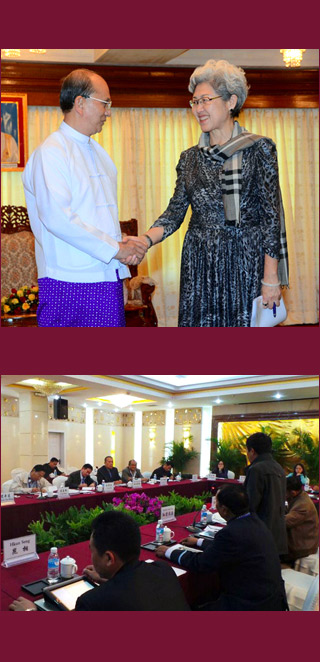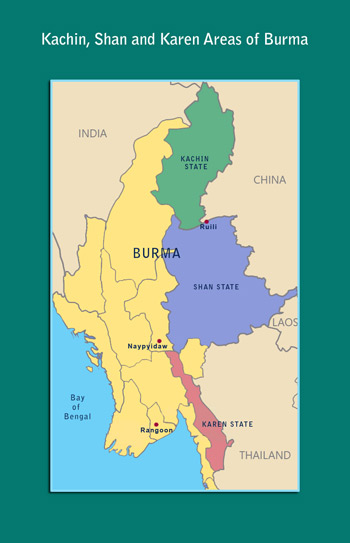Burma’s President Thein Sein, while
visiting Europe, announced that the government’s fighting against ethnic
resistance forces has ended – even as the government moves more troops
into the troubled areas. Meanwhile, the United States and China are
scrambling for influence by brokering peace to end the ethnic conflicts.
Dozens of think tanks and NGOs from the West are attracting donor funds
and pouring into the country. “The outcome has been overlapping
initiatives, rivalry among organizations – and, more often than not, a
lack of understanding by inexperienced ‘peacemakers’ of the conflicts’
root causes,” explains journalist and author Bertil Lintner. China,
unhappy with Burma’s embrace of the West, has been actively leading
peace talks since January. Lintner points out that China’s Yunnan
Province has more than 130,000 ethnic Kachin who sympathize with their
fellow Burmese Kachin. Motivations may differ, but China and the US both
want the conflicts to end. Burma’s leaders may find it difficult to
pursue military solutions, continuing sending troops north, while
playing China and the United States off each other. – YaleGlobal
Powers Seek Influence in Burma’s Conflict
Burmese government battles insurgents as China and the US scramble for influence
YaleGlobal, 18 March 2013
 |
| Border diplomacy: Chinese Special Envoy Fu Ying delivers a tough message to Burmese President Thein Sein on Jan 19, 2013 (top); Burmese Minister of the President's Office Aung Min (3rd Left) and other government officials held talks with representatives of the Kachin Independence Organization, in the Chinese border town of Ruili on February 4, 2013 |
Foreign intervention in Burma’s peace process is becoming a war by proxy, dividing policymakers in every country involved.
The Burmese government seems intent on a military solution to its troubles with ethnic insurgency. As delegates gathered for March talks with insurgents in the border town of Ruili, hundreds of Burmese army trucks were sending more soldiers and heavy equipment into Kachin State.
Yet in Europe only a few days earlier, President Thein Sein, ex-general-turned-civilian politician, proclaimed, “There’s no more fighting in the country, we have been able to end this kind of armed conflict” between government forces and an abundance of ethnic resistance armies. This despite almost daily attacks against the Kachin Independence Army, KIA in the far north, frequent skirmishes with the Shan State Army in Shan State – a group that has an official ceasefire agreement with central authorities – and more government troops taking up new positions in Karen State in the hills bordering Thailand.
While western NGOs and think tanks are scrambling to engage in Burma peacemaking, the mighty neighbor to the north is taking charge. On 13 March, former Chinese Premier Wen Jiabao admitted that decades-long ethnic conflicts are having a severe impact on cross-border trade, yet China would continue to develop cooperative relations “based on the five principles of peaceful coexistence, including non-interference in each other's internal affairs.”
 |
| Areas of Burma. Enlarge Image |
Chinese methods for promoting peace differ considerably from the “peace-and-reconciliation-through-dialogue” approach of western interlocutors. In Kachin State, China is waving a carrot to the government in Naypyidaw by putting pressure on the KIA and allowing Burmese troops to detour through Chinese territory. China is waving a big stick as well. According to Jane’s Intelligence Review, 21 December, China has supplied Burma’s most powerful ethnic militia, the United Wa State Army, UWSA, with large quantities of military hardware. Chinese-made armored personnel carriers with machineguns have been spotted in the UWSA’s Panghsang headquarters in Burma across the Yunnan frontier.
The UWSA has had a ceasefire agreement with the Burmese government since 1989. China does not want another war. By letting the UWSA acquire heavy weaponry, China sends a strong message to Naypyidaw: Don’t mess with us.
It’s hardly secret that China is unhappy with Burma’s moves to improve relations with the West, especially, the United States. Beijing is still smarting from the Burmese government’s decision in September 2011 to suspend construction of a US$3.6 billion China-backed mega-dam in Kachin State, which would have flooded 600 square kilometers of forestland, displaced thousands of villagers and supplied 90 percent of its electricity to China. Two months later, then US Secretary of State Hillary Clinton paid a historic visit to Burma, the first in decades by such a high-ranking Washington official. Burma’s drift away from its close relationship with China had begun, and the West responded with enthusiasm. Sanctions were eased, aid and investment pledged; criticism of human-rights abuses by the Burmese army in ethnic minority areas all but disappeared from agendas of Western governments.
|
It’s hardly secret that China is unhappy with Burma’s moves to improve relations with the United States. |
Chinese-sponsored peace talks were held in Ruili in Yunnan Province 3 February. Beijing sent a senior official, Luo Zhaohui, former ambassador to Pakistan and now director general of the Department of Asian Affairs at the Foreign Ministry, to observe the process. A second round of talks at Ruili, 11 March, was attended by Wang Yingfan, another high-ranking minister of foreign affairs.
The Chinese intervention in Burma’s civil war casts doubts on the feasibility of foreign-mediation efforts – as does the proliferation of western organizations which have turned peace in Burma into a virtual industry and, for some, a lucrative business. The Norwegian-initiated Myanmar Peace Support Initiative has been followed by similar efforts by the Switzerland-based Center for Humanitarian Dialog, the Nippon Foundation of Japan and EU-sponsored initiatives through the Myanmar Peace Center, an entity close to the Burmese government. The Institute for Security and Development Policy, a Swedish think tank, also has EU funding for “national reconciliation and peace-building” with ethnic groups, while Pacta, a Finnish NGO, looks for opportunities as well. The Phnom Penh-based Center for Peace and Conflict Studies is involved, too, as are at least six individuals with their own private agendas. Millions of dollars and euros are at stake in these efforts.
|
In Burma, there’s rivalry among peace organizations, often with lack of understanding of the conflicts’ root causes. |
The Chinese approach may also lack cohesion. In December, several closed-door meetings were held in Beijing where Yunnan-based academics argued that the Chinese government should close the border and collaborate only with the Burmese authorities to crush the KIA, thus improving the strained relationship with Naypyidaw. Foreign ministry officials reportedly warned that such a one-sided view could lead to an influx of Kachin refugees into Yunnan and possibly attacks on Chinese businesses and individuals.
Moreover, China must take into account that Yunnan province has more than 130,000 ethnic Kachins. When the KIA was under fierce attack by helicopter gunships, fighter jets and heavy artillery in January, several thousand Chinese Kachins travelled by truck and bus to the border to show solidarity with brethren on the other side. More Chinese Kachins were stopped at checkpoints before the border. Given the sensitivity of China’s handling of ethnic issue as seen in regions such Tibet and Xinjiang, Beijing cannot afford to antagonize yet another minority people, even if it is relatively small.
With both the West and China demonstrating ineptitude in refereeing Burma’s ethnic conflict, the internal wars that have plagued Burma since independence from Britain in 1948 appear nowhere near a solution.
Bertil Lintner is a Swedish journalist based in Thailand and the author of several works on Asia, including Blood Brothers: The Criminal Underworld of Asia and Great Leader, Dear Leader: Demystifying North Korea Under the Kim Clan. Click here for an excerpt of his recent book, Great Game East: India, China and the Struggle for Asia’s Most Volatile Frontier. He can be reached at lintner@asiapacificms.com.
Rights:Copyright © 2013 Yale Center for the Study of Globalization
http://yaleglobal.yale.edu/content/powers-seek-influence-burmas-conflict#comment-68928

















